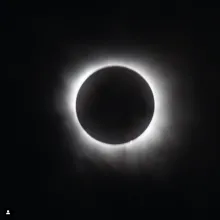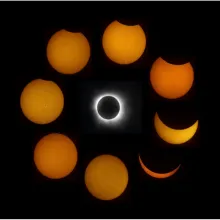Elevating Graduate Research with Visual Communication: Insights from University Experts
We spoke with four experts from the University of Arizona to gain their perspectives on how graduate students can effectively leverage visual storytelling to enhance their presentations and publications.

Graphic depicting visual communication.
In today's fast-paced, content-heavy world, visual communication plays a critical role in how information is perceived, understood, and retained—especially for graduate students presenting complex research. Whether delivering data-driven insights to academic peers or engaging broader, non-specialist audiences, clear and compelling visuals can make a significant difference. We spoke with four experts from the University of Arizona to gain their perspectives on how graduate students can effectively leverage visual storytelling to enhance their presentations and publications.
Storytelling through Data Visualization

Greg Chism, Assistant Professor of Practice at the University of Arizona College of Information Science
According to Greg Chism, Assistant Professor of Practice at the University of Arizona's College of Information Science, the key to successful visual communication lies in understanding your audience. "The best thing you can do is have a clear story," Chism explains. “The audience isn’t you, the grad student. You need to think about who they are and what they already know." By tailoring visuals to the audience's level of understanding, students can ensure their message is both accessible and engaging.
Chism emphasizes the importance of keeping visualizations minimalistic and avoiding overcrowding with information. To do this, he also points to the data-to-ink ratio, recommending that students focus the bulk of their design efforts on the data itself. "More ink should be used on the data than on everything else," he says, adding that strong visuals often lead to simpler, more effective presentations.
It is also important to consider accessibility, such as using alternative text for screen readers and designing with color-blindness in mind, Chism explains. He stresses the importance of designing for inclusivity and making sure that visuals align with design principles aimed at enhancing data visualization.
Each visualization is designed for a specific purpose – Chism stresses the importance of understanding the "why" behind choosing one visualization over another and advises taking courses or reading resources, like Best Practices for Data Visualization from the Royal Statistical Society, to build a foundation in data visualization. "Learning the fundamentals of why some visualizations work over others is essential," Chism advises.

Craig Reck, Manager of Communications and Content at University of Arizona Research, Innovation, and Impact
Making Research Accessible for General Audiences
Visual communication isn’t just important in academia—it’s vital in a world dominated by digital content, says Craig Reck, Manager of Communications and Content at University of Arizona Research, Innovation, and Impact. “Visuals are everything, especially in a world where everyone is glued to their phones,” Reck notes. He highlights that visuals such as infographics or short videos have the power to stop people from simply scrolling past research content. "A strong visual will not only grab attention but also make people stay long enough to go deeper into the research."
For example, in this @uazresearch post (see Image A), an animation of a black hole catches the viewer's attention immediately. Reck points out that most people may not be able to put together an animation like this, but an engaging graphic doesn’t need to be complex, and it certainly doesn’t need to explain all the science.

Image of a solar eclipse found on the @uazresearch Instagram page taken from Fredericksburg, Texas, by LPL professor Vishnu Reddy and his Space4 Center team and by Lucille Le Corre of the Planetary Science Institute.
Its main function is to draw someone in and spark curiosity, leading them to engage further with the research. Sometimes, it's not about the scientific precision of the visual but rather its ability to catch the eye.
The visual depicting a solar eclipse in this Instagram post, despite not looking like much, garnered the highest engagement on the page this year. Reck highlights that this demonstrates how a simple, clean visual can resonate with audiences, capturing attention and sparking interaction, without needing to be overly complex.

Images of the April 8 solar eclipse taken from Fredericksburg, Texas, by LPL professor Vishnu Reddy and his Space4 Center team and by Lucille Le Corre of the Planetary Science Institute. Montage: Lucille Le Corre.
Similarly, this visual of a solar eclipse over time (see Image B), showcases the University of Arizona’s top-performing post. This type of content, Reck notes, is accessible and low-barrier, allowing even those without a deep understanding of the scientific data to engage with and appreciate the research. It shows that for less data-heavy topics, there are still engaging ways to visually communicate growth, change, or progress through motion or time-lapse videos.
For graduate students, making complex topics digestible is a key challenge. Reck suggests starting with a simple exercise: break down your research until you can explain it in 10 seconds. "When you put limits on yourself, you find the key idea you want to convey," he explains. Once you’ve found that core message, the visuals can help clarify and support it. Reck points out that catching the audience’s attention often matters more than getting every scientific detail across in a single visual. For less data-heavy research, Reck advocates using motion or timelapse videos to show growth, change, or progress, which can engage the audience.

Georgia Davis, Director of Multimedia and Creative Initiatives at the University Center for Assessment, Teaching, and Technology
Visual Communication in a Multimedia Landscape
Incorporating visuals into storytelling is a critical part of Georgia Davis and Luis Carrión’s work at the University Center for Assessment, Teaching, and Technology. Davis, the Director of Multimedia and Creative Initiatives, and Carrión, the Multimedia Team’s Field Production Manager, both emphasize the power of combining verbal and visual elements to create memorable research presentations. "We process information in two ways: verbally and visually," says Davis. "When you see and hear something at the same time, you connect with it more deeply."
Carrión, a multiple Emmy Award winner, encourages students to explore different ways of engaging their audience. “Clarity is key,” he states, noting that dynamic visuals, photographs, and storytelling can make presentations more interactive. “Grad students need to reimagine traditional academic presentations, moving from a ‘sage on the stage’ model to something more engaging.”

Luis Carrión, Multimedia Team Field Production Manager at the University Center for Assessment, Teaching, and Technology
The broadcast journalism-trained duo also stresses the importance of humanizing research through visual storytelling. By relating research themes to personal experiences and making them more relatable, students can build stronger connections with their audience. Davis adds, “The more you connect with the person you are learning from, the more motivated you are to put time into understanding their work.”
Tools and Resources for Enhancing Visual Communication
All four experts agreed that the right tools can significantly enhance a graduate student’s ability to communicate their research. Chism recommends programmatic tools like R and Python for more complex statistical visuals, but also mentions user-friendly, no-code platforms like RAWGraphs and Datawrapper. Reck points to Adobe Express as an excellent tool for graduate students without extensive design experience, enabling them to create visually appealing content without needing full Adobe Suite proficiency.
Davis and Carrión emphasize the value of storytelling techniques and suggest integrating photography and video into presentations, even in unexpected ways. “There is much more acceptance of multimedia in academia,” Carrión explains. Tools like Adobe Premiere for video editing and UCATT's multimedia resources can help students expand their visual communication toolkit.
For those looking to dive deeper into visual communication, the University of Arizona offers a range of workshops and courses across departments, including Chism's INFO 526 course, which attracts students from multiple disciplines eager to learn the art of data visualization.
Conclusion: Visual Communication as a Key to Research Success
Visual communication is no longer a "nice-to-have" skill—it's a necessity for graduate students looking to make their research impactful and accessible. By focusing on clear storytelling, keeping visuals simple and tailored to the audience, and leveraging available resources, students can enhance the quality and effectiveness of their research presentations.
As Chism, Reck, Davis, and Carrión all highlight, visuals have the power to transcend the academic realm, making research more accessible, engaging, and impactful for diverse audiences. By leveraging these insights and tools, graduate students can ensure that their hard work not only reaches but resonates with their intended audience.
Resources for Graduate Students
- Best Practices for Data Visualization from the Royal Statistical Society
- R and Python for programmatic visualizations
- RAWGraphs and Datawrapper for no-code tools
- A Data Storyteller’s Guide to Avoiding Clutter
- Data-ink Ratio: How to Simplify Data Visualization
- Adobe Creative Cloud resources for design
- UA Library Workshops and Data Lab Consultations
- UA RII Data Science Institute Calendar for upcoming workshops and events
- INFO 526 Graduate Course on Data Visualization (Professor Greg Chism)
- SBS 350 Undergraduate Course Introduction to Adobe Creative Cloud for Multimedia Projects (Professor Melody Buckner, and Lead Adobe Specialist Alex Gonzales)
- UCATT multimedia resources
- Effective Presentation Design and Delivery from Georgetown University
- R.E. Mayer’s article “Using multimedia for e-learning” discusses concepts such as cognitive load and how to use visuals effectively
- On-Campus Digital Makerspaces house computers loaded with the Adobe Suite and employ student workers who can help individuals use the software
For more resources and guidance, visit the Graduate Center’s Visual Communication Resources page.

